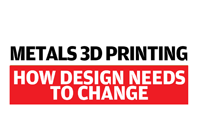

A change from design for manufacturing towards manufacturing for design is key when it comes to metals 3D printing.
For decades, manufacturing processes have influenced feasible geometries and product functionalities.
3D printing has introduced innovative approaches for product design, allowing designers to realise product features like complex hollow structures, overhangs and lattice structures that can be hard or even impossible to manufacture otherwise.
It’s key to understand this high geometrical freedom and to
use it to its full advantage when designing functional parts.
To benefit from this freedom, and other opportunities presented by 3D printing, the design process must be adapted.
Product studies of metal 3D printing conform designs show that the potential is high, but also show that conventional design approaches are not always suitable.
The designer must be aware of the possibilities and account for these in the early stages of the design process.
It’s no longer a question of working past the restrictions of manufacturing technology, but rather starting from and being led by the part’s functionalities.
This then enables the designer to create something that inherently realises the capabilities of 3D printing in its design.
Remember, with metal 3D printing, the costs are based on the volume of the part and not on its complexity, and this allows for greater freedom in exploring complex designs.
The fields of bionics and structural optimisation, in particular, show a great potential for industrial applications.
These approaches often lead to highly complex freeform structures that take the design freedom that metal 3D printing offers and turns it into superior product functionalities.
And the toolless nature of the manufacturing process supports a product range with a high variance, beneficial for mass customisation.

How is design changing to encompass metals 3D printing? It’s a great question.
The first thing to note is that the question implies that design needs to change and that is a key point to consider.
At Renishaw, we are often asked to build samples and benchmarks that are quite clearly unsuitable for powder bed metal 3D printing processes, where there are more challenges with build support structures compared to polymer 3D printing support where structures can be more easily removed.
The best designs either incorporate supports into the design that are not removed, or change the design radically to remove the requirement
for supports altogether.
Key ingredients here are design authority, a clear understanding of the functional requirements of the part and the economics of using 3D printing as the serialised production route.
It is clear that without design authority, nothing can change!
Understanding the interplay between functional requirements and build economics is vital.
Many of the advantages offered by 3D printing in functional parts relate to the ongoing lifetime benefits that the designs offer – these include part consolidation, efficiency improvements because of clever design of conformal channels, lighter weight of components, and in some cases, the ability to use a more advanced or challenging material because you are not constrained by conventional casting or machining.
The major challenge here is to change the way the advantages brought by 3D printing are represented in the value proposition.
If you simply look at manufacturing cost, without taking into account the upstream and downstream benefits offered by 3D printing, such as inventory management and improved performance in service, we will all be waiting a long time before we fully realise these advantages.
So perhaps another important question that needs to be answered is this one: “What does industry need to do to ensure consumers understand the additional value offered by 3D printing?”

Additive Manufacturing releases the designer to create things that are truly innovative and intended.
In the past, many designs were restricted by the fabrication process associated with traditional metalcraft, such as milling or even 5-axis machining.
With the adaptation of a wider selection of metals into 3D printing, we see designers able to create objects from titanium hip socket replacements to full-sized bicycle frames – both of which would have previously been impossible with resin- or plastic-based 3D printers.
The additive process allows for a complexity of shape that even the smallest subtractive tools could not get into to remove material.
In the consumer space, we have seen a wide adoption of this process in the jewellery market, taking a profession as old as craft itself and allowing it to grow in complexity of shape and surface texture.
In the medical field, this is quickly becoming the largest innovation for this industry in decades.
A great example is the amazing technology being developed by Within Technologies, such as the custom 3D printed ribcage now worn by a 54-year old cancer patient in Spain.
But while the process is growing more popular and useful industrially, it has taken a bit longer to see rapid adoption among makers and DIY-ers.
Their interaction most likely tends towards customising printed objects, as seen with Shapeways’ customised jewellery.
The metal printing process requires high temperatures and a highly controlled printing environment, which does make for a higher-cost print.
I do believe though that, in time, the costs will go down and we will see technology more adapted to the start-up space, with people making more functional prototypes and even larger-run manufacturing of metal parts that could not be fabricated by other methods.

Technically, design does not have to change to accommodate the rise of metal additive manufacturing. The same old conventional designs will print just fine on a direct metal 3D printer.
However, if we continue to feed traditional designs – those optimised for subtractive and/or formative manufacturing processes – into additive systems, we will never tap into the levels of optimisation that an additive process supports.
Ask your designers, what would an engineered solution look like if you removed the correlation between cost and complexity? In the 3D world, this is how designers must train themselves to think.
It’s not necessarily a bad thing; in many ways, design for additive is easier than design for subtractive, with fewer rules, fewer constraints, fewer compromises. It’s a chance to design for performance, not design for manufacturing.
So what are the objectives of 3D design thinking? It might be to maximise a part’s strength- to-weight ratio, for example, or to maximise the efficiency of thermal transfer.
Mathematically, there is always an optimal solution, the apex of a statistical curve. The challenge has always been that, geometrically, it’s highly unlikely that this solution happens to align with the constraints of conventional manufacturing.
3D printing makes that kind of optimisation possible.
And because optimal engineering solutions are mathematical functions, it is only a matter of time before 3D design engineering itself becomes automated: driven by an advanced, recursive, FEA-driven algorithm, constantly evolving geometry, applying load, moving and optimising the distribution of voxels of material, generation by generation, to yield the optimal design.
In the here and now, there are a few key rules we must consider when designing for the 3D printing in metal process.
As software and hardware capabilities continue to grow, I expect many of the remaining constraints to disappear, ushering in a new era of design freedom.
Automation is the future of design, and this future is made possible only by 3D printing.
Let us know your thoughts on what needs to change, in the comments section below.

Experts give their thoughts on the shift needed to reap the benefits
Default






